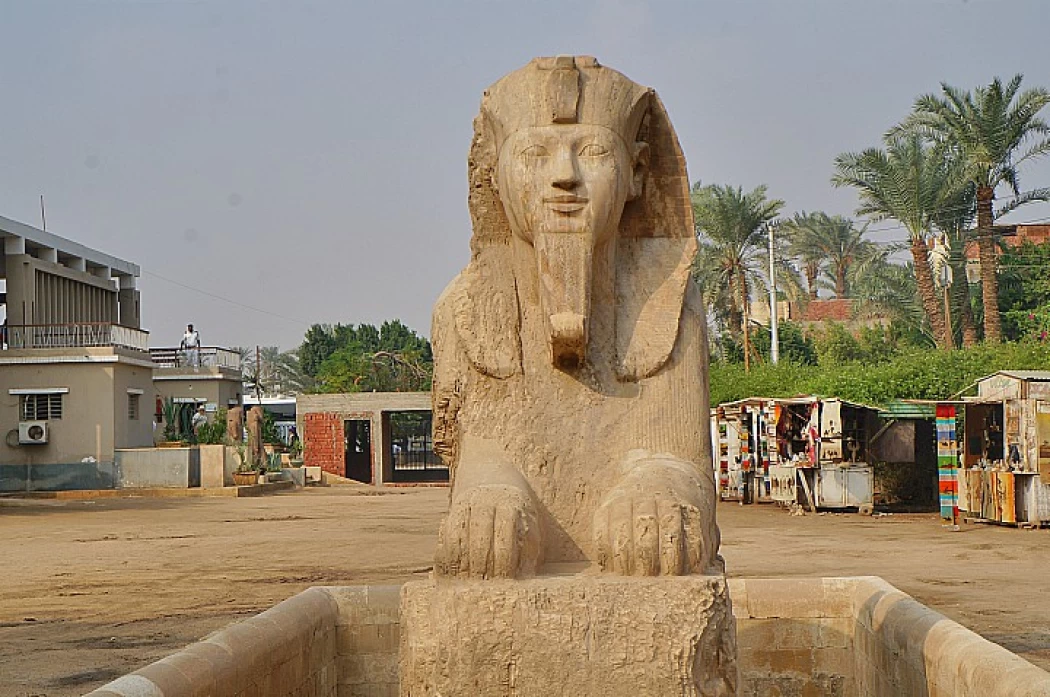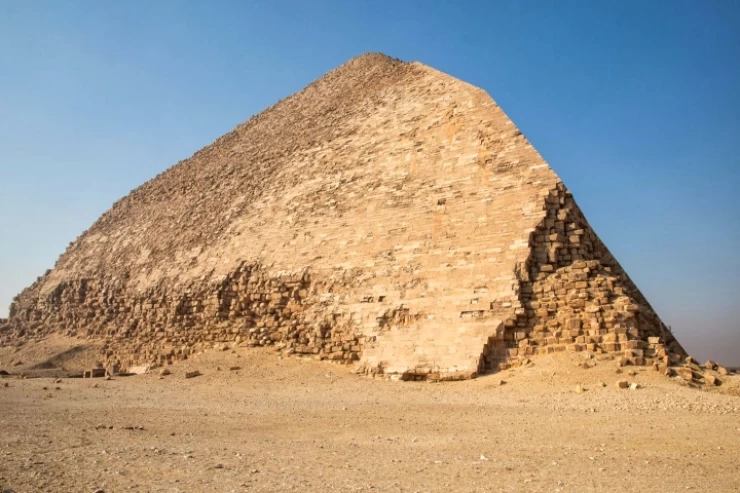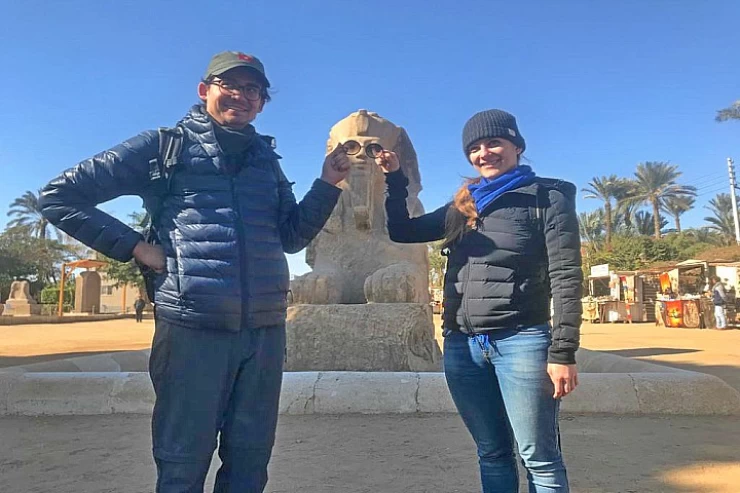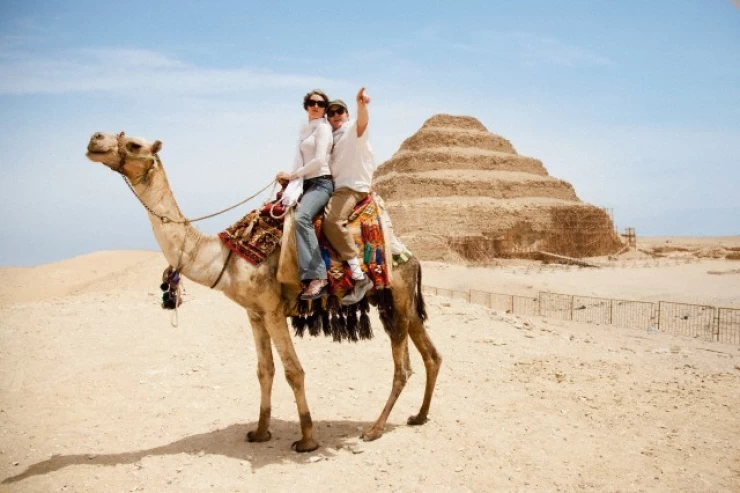
Memphis Ägyptens alte Hauptstadt
Memphis | Antike Stadt von Memphis
Memphis ist eine der faszinierendsten archäologischen Stätten und Aktivitäten in Kairo. Es war die alte Hauptstadt Ägyptens, die im Altertum als "Inebu-Hecke" bekannt war.
Freilichtmuseum von Memphis
Der Name konnte von den Griechen nicht ausgesprochen werden, daher nannten sie ihn nach dem Namen einer der Pyramiden an der Stelle der Stadt, die Pyramide ist genannt Mn Nefer, was schön und stabil bedeutet. Mn-Nefer wurde korrumpiert, um Memphis zu sein, dann konnten die Araber es nicht sagen, also nannten sie die Stadt Manf, und dieser Name wurde schließlich von den modernen Ägyptern als Mit-Rahina ausgesprochen, und das bleibt der heutige Name, wo sich eine solche kosmopolitische Stadt befand. Früher war es der Vorname von Unterägypten.
Es wurde vom Pharao Menes gegründet und war während des Alten Reiches die Hauptstadt Ägyptens. Die Ruinen befinden sich in der Nähe der Stadt (Mit Rahina), etwa 20 km südlich von Gizeh. Es befindet sich an einer strategischen Position an der Mündung des Nildeltas, weshalb es während der gesamten alten ägyptischen Geschichte eine wichtige Stadt blieb.
Sein Haupthafen enthielt eine hohe Dichte an Lagerhäusern, die Lebensmittel und Waren im gesamten alten Königreich verteilten. Werkstätten, Fabriken und man muss bedenken, dass Memphis während seines goldenen Zeitalters als regionales Zentrum für Handel, Religion und Handel gedieh.
In einem begrenzten archäologischen Gebiet, in dem sich der Tempel von Ptah befand, gilt Ptah als die Hauptgottheit von Memphis. Er wurde als Schöpfergott verehrt, und seine Frau Sekhmet und ihr Sohn sind Nefertum.
Im modernen Museum von Mit Rahina sind einige kolossale Statuen ausgestellt. Die größte zeigt Ramses II., Der zerstört und verstümmelt gefunden wurde und ursprünglich mehr als 13 m hoch war.
Memphis wurde 1000 Jahre lang in acht aufeinanderfolgenden Dynastien während des Alten Reiches die Hauptstadt des alten Ägypten. Es erreichte seinen Höhepunkt unter der 6. Dynastie als Zentrum für die Verehrung von Ptah, dem Gott der Schöpfung und der Kunstwerke.
Der Tempel von Ptah, der von der Alabaster-Sphinx bewacht wird, dient als Denkmal für die frühere Macht und das Ansehen der Stadt. Die Memphis-Triade, die aus Gott Ptah, seiner Frau Sekhmet und ihrem Sohn Nefertem besteht, stand im Mittelpunkt des Gottesdienstes in der Stadt.
Memphis lehnte während der 18. Dynastie mit dem Aufstieg von Theben ab und wurde im Rest des Neuen Königreichs und auch unter den Persern restauriert, bevor es nach der Gründung von Alexandria wieder ignoriert wurde. Während des Römischen Reiches blieb Alexandria die wichtigste ägyptische Stadt. Die zweite Stadt Ägyptens bis zur Gründung von Fustat (oder Fostat) im Jahr 641 n. Chr. Blieb Memphis.
In letzter Zeit war es weitgehend menschenleer und wurde zu einer Steinquelle für die umliegenden Siedlungen. Jetzt hat es immer noch eine beeindruckende Reihe von Ruinen, die aus dem zwölften Jahrhundert stammen, aber bald etwas mehr als eine Fläche aus niedrigen Ruinen und verstreuten Steinen wurden.
Memphis soll unter dem Schutz des Gottes Ptah, des Schutzpatrons der Künstler, stehen. Der prächtige Tempel Hut-ka-Ptah war zu dieser Zeit eines der führenden Bauwerke der Stadt, und es besteht kein Zweifel daran, dass die Ruinen der ehemaligen Hauptstadt heute einen fragmentierten Beweis für ihre Vergangenheit bieten. Sie sind zusammen mit dem Pyramidenkomplex von Gizeh seit 1979 als Weltkulturerbe geschützt. Die Stätte ist als Freilichtmuseum für die Öffentlichkeit zugänglich.
Heute gehört das Freilichtmuseum, in dem Memphis früher stand, zu den meistbesuchten Orten während vieler Ägypten-Touren, die hier aufgeführt sind:
Erleben Sie den Zauber Ägyptens, wo alles beginnt, mit dem professionellen Team von Cairo Top Tours. Starten Sie jetzt Ihr Abenteuer und erleben Sie den besten Urlaub in Ägypten. Sie finden hier die besten Ägypten-Osterangebote und -Urlaube 2022.
Der Frühling in Ägypten ist perfekt und die Atmosphäre ist unsagbar schön. Wir organisieren tolle und unterhaltsame Ägypten Ausflüge wie Kairo Tagestouren. Schauen Sie sich unsere Ausflüge und Reisen mit angemessenen Preisen an, die für alle Arten von Touristen im Jahr 2022 geeignet sind, sowie Ägypten Landausflüge, zusätzlich zu Kairo Tagestouren vom Flughafen und Kairo Zwischenlandung Tour.
Sie können das antike Theben erkunden, beginnend mit dem Tal der Könige und dem Westufer von Luxor, sowie den Karnak-Tempel und den Luxor-Tempel. Ägypten Touren erweitern, um den Tempel von Edfu von Gott Horus der Falke, und Kom Ombo Tempel und Abu Simbel zu decken. All dies während Assuan-Tagestouren und Luxor-Tagestouren.
Das Rote Meer ist einer der malerischsten Orte, die Sie in Ägypten besuchen können, genießen Sie einige Meeresabenteuer und Wanderaktivitäten wie Hurghada Tagestouren und Sharm El Sheikh Ausflüge. Sichern Sie sich jetzt Ihren Platz in unseren Ägypten-Reisepaketen und Wüstensafari-Trips, um von Kairo aus die Oasen Siwa, Bahriya und Farafra sowie die Oasen Dakhla und Kharga zu bereisen! Wir sehen uns wieder.
Wenn du neugierig auf die Stadt Gizeh bist und wissen willst, wie sie vor langer Zeit ausgesehen hat, kannst du dir eine Website mit dem Titel Is It safe to travel to egypt? ansehen. Dort findest du coole Sachen wie Bilder und Fakten über Gizeh, die dich über die Geschichte der Stadt aufklären.
Located on the western banks of the Nile, southwards of Cairo stands one of the most significant historic and archaeological centers in Egypt, Memphis. This ancient metropolis existed as the capital of Egypt for approximately two thousand years from its establishment about in 3100 BC until it was overtaken by the might of Thebes and Alexandria. Given its foundation at the very earliest periods in Egyptian history and civilization, we can safely conclude that Memphis was more than just an administrative and political area but had active religious practice. Nowadays, although most of Memphis has perished over the years, the few remains still help one to piece together the colorful history of Egypt.
Let’s embark on a mission to unearth the beauty of Memphis and its history by visiting its fabulous buildings, temples, and sculptures that have endured the test of time.
The Birth of Memphis: A Historical Overview
According to popular belief, Memphis was founded by King Mena oder Narmer, who was the first ruler to unite Upper and Lower Egypt into one kingdom around 3100 B.C. Memphis, or Ineb Hedj, as the ancient Egyptians named it (translated into English as White Walls), was, on the other hand, quite favorablely located, at the delta of the Nile, where the river finally met the enormous desert. This made it a center on transport and trade activities, which connected Egypt with the Mediterranean Sea, Africa, and almost the entire world.
It did not take long before Memphis became an affluent city and the center of governance, economy, and arts in Egypt. In the course of history, it survived and thrived in the course of multiple periods of dynasties, with the Egyptian kings erecting grand and expensive palaces and temples as well as tombs. Such influence of the city lasted until the period of the Greco-Roman domination when Alexandria took over the center of power and Memphis started losing its significance over time.
Besides being the seat of power, Memphis was one of the chief religious centers in the entire ancient Egyptian world. It was here that the chief god, Ptah, was the god responsible for creation and crafts, with many temples dedicated to him and pilgrimage worshipers and qualitatively provided all over Egypt. As a passive creator, ‘one who brings into existence only by the utterance of a word’, it is easy to think why he was so significant to the hierarchy of the Egyptian gods. The most prominent temple within the city, the Temple of Ptah, dedicated to this god, attracted a great number of visitors and worshippers coming from different parts of Egypt.
In due course, more deities came to be worshiped in Memphis, such as Sekhmet, the warrior goddess of the lion’s head, who prophetically wards diseases, and Nefertem, the lotus god of regeneration. They were also known as Ptah’s family together with God Ptah, where they enhanced religious activities in the city of Memphis as religious activities became more focused.
Ruins have taken over a large section of Memphis today; however, whatever is left gives a snapshot of the city in its glorious days. Below are some of the most notable structures that have survived the test of time:
1. Temple of Ptah Statue
The Temple of Ptah is regarded as the center of all temples in Memphis and is arguably the 2nd Largest Temple in Ancient Egypt. Great losses have been incurred by the temple throughout time; however, archaeological excavations have retrieved traces of its pillars, images, and altars.
The temple complex also comprised several matrixes of courts, shrines, and chapels connected by hallways in which priests conducted rituals and offered sacrifices. Today the visitors will notice some broken colossal statues of the pharaohs that exist within the premises of the temple, showing the temple in its full splendor.
2. The colossal Statue of Ramses
One such famous monument of Memphis is the enormous limestone statue of Ramses II. Which is supposed to have been more than 30 feet high when standing with the statuette depicting the pharaoh in a striding position intricately decorated with several details of the headdress and attire worn by the king.
At the moment the statue is on display horizontally in the Memphis museum, enabling the audience to see the workmanship and proportions better. The Cairene sculptor in a low classical style statue of Ramses II holding a scepter in Memphis is indicative of one of the great kings of Egypt and also one of Egypt's greatest legacies.
3. The Alabaster Sphinx
Situated close to the gigantic image of Ramses II, the Alabaster Sphinx is a stunning artwork that weighs around 80 tons, stands roughly 13 feet in height, and extends 26 feet in length. It is assumed to have been created during the reign of Amenhotep II (18th Dynasty) and is believed to depict either him or his heir.
In contrast to the Great Sphinx of Giza, which was built out of limestone, the Alabaster Sphinx is made of one piece of alabaster, which is a sweet translucent stone. It is beautifully serene, and the features are expertly sculpted, which shows the emotions of Egyptian art vividly.
4. The Burial Tomb of Horemheb
General Horemheb, who would later assume the title of king, is interred in a sarcophagus that has been placed inside the Saqqara complex; however, he had stronger associations with Memphis. While Tutankhamun sat on the throne, he served in a prominent position as commander within the city and therefore knew its corridors too well. His is a handsome tomb covered with reliefs of his victories and greatness in arms.
This tomb provides much pertinent information on the 18th Dynasty as well as the political climate of Memphis during the reign of Horemheb in terms of arts and culture.
Recent Discoveries: Unearthing Memphis’ Hidden Treasures
Memphis remains a hotbed of archaeological activity today, with recent findings opening new windows into the previously obscure city. The remains of ancient statues, sarcophagi, and other pieces of art have been excavated from several periods of history in Memphis, which contributes to understanding this corner of the world.
In the hot seasons of recent years, archeologists dug up a high number of Sekhmet’s statues, which means that she and her worshippers’ devotion was cosmically present in Memphis. Moreover, ascertaining factors about their lives has also been demonstrated by the discovery of sepulchers of priests and other city officials, as well as that of artisans who were responsible for serving the city’s temples.
Memphis’ Legacy: The Rise and Fall of an Ancient Capital
Memphis was more than a political seat but a cultural and intellectual powerhouse. The city attracted many artists, scribes, and scholars, all of whom played a part in the artistic and literary development of Egypt. However, this was true until other regions grew into power; the seat of governance was moved to Thebes and later Alexandria, leading to the stagnation of Memphis.
Economic decline in the city occurred at a slow pace, but it was already noticeable during the Roman occupation. With the rise of Alexandria as the major educational and commercial hub, the temples and monuments of Memphis were neglected, and the city itself was eventually buried beneath the shifting sands of the Nile Delta.
Visiting Memphis Today: A Step Back in Time
Even though the majority of ancient Memphis has been reduced to ruins, the location is a significant place for people who are interested in the history of Egypt. The open museum that is found in Mit Rahina depicts the resplendent past of the city, with sculptures, sphinxes, and pieces of temples set in a calm environment.
Guided Tours: A guided tour is advisable since a narrative accompanying the monuments adds value to the monuments. A well-informed guide is capable of animating the ruins, making the visit worthwhile.
Combine with Saqqara: Expect Memphis to include a Saqqara tour as the Saater cemetery is just a few kilometers away. This is the best way to understand the evolution of funerary architecture and practices in general in ancient Egypt.
Photography: The place is also very good for photography, particularly for the giant statues and the Alabaster Sphinx. The old statues can be more delightful in the morning or evening when the light is not harsh.


















